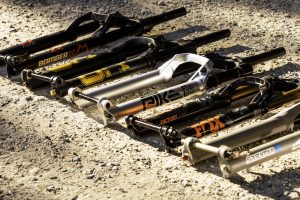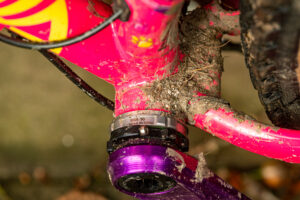Yes, the Trek Slash 9.8 XT is a great choice for enduro, but its capable, lively ride makes it a great do-it-all choice for the one bike quiver
Trek Slash 9.8 XT review
The Trek Slash 9.8 XT is an enduro bike with progressive geometry and 29er wheels and 170/160mm of travel, and offers a performance that seriously impressive. Good enough to make it on our list of the best enduro mountain bikes? Absolutely. It’s good enough to score a 10 out of 10; a rare feat.
Trek Slash 9.8 XT need to know:
- Mino Link geometry adjustment allows for a 27.5in Mullet setup
- KnockBlock 2.0 offers an increases the steering angle from 58º to 72º and can be removed if needed
- A bash guard on the MRP chain guide helps protects the 30t XT chainring
- RockShox Super Deluxe Ultimate shock sports ThruShaft technology to control the 160mm travel

mbr bike test editor putting the Trek Slash 9.8 through its paces
We took the Trek Slash 9.9 XO1 for a first ride when it launched last year, and while the 2022 bike looks remarkably similar, right down to the frame colour of the bike we featured last time, there are several differences. The main one being that the XT equipped bike is £1,500 cheaper and there are changes to the specification that reflect its lower price.
You get a full Shimano XT drivetrain and 4-piston XT brakes, rather than SRAM XO1. You also get a RockShox Zeb Select+ fork rather than the Ultimate, while the Bontrager Line Carbon 30 wheels switch to the alloy version. Downgrades? Yes, but none that should detract from the underlying ride quality of the Slash.

A full Shimano XT drivetrain including cranks
The most important thing is that the OCLV carbon frame remains unchanged, so you still benefit from all of the advances in the frame geometry and suspension that Trek introduced last year. Updates that saw the addition of downtube storage, the head tube angle getting slacker, the seat tube steeper and the reach longer. Trek also made the suspension more progressive, and increased rear travel by 10mm to 160mm. All positive changes then.
Trek Slash 9.8 suspension
Trek has always been a big proponent of proprietary suspension components. As such, the RockShox Super Deluxe Ultimate shock on the Slash 9.8 XT features Trek’s ThruShaft technology and it’s the exact same shock that comes on the flagship model. This design eliminates the need for a high pressure IFP (internal floating piston) and in simple terms, this allows for lower breakaway resistance and improved sensitivity. And because the damper shaft passes straight through the shock body, it needs an extender mount and a small hole in the frame to accept the ThruShaft at bottom out.

This might be a cheaper bike but the RockShox Super Deluxe Ultimate shock is the exact same shock that comes on the flagship model
Sounds complex? Well it is, but thankfully setting up the suspension on the Slash is as easy as 1, 2, 3. Sag gradients make it simple to dial in the correct air pressure, and in the open setting the shock has three low-compression settings for fine tuning the response to pedal inputs or the style of terrain you’re riding. Also if you ever want to fit an aftermarket shock, that’s still possible as the Slash uses a 230×62.5mm metric shock size, you’ll just need different lower mounting hardware.
Setting up the suspension on the Slash is as easy as 1, 2, 3
Up front the 170mm travel RockShox Zeb Select+ lacks the high speed compression adjuster found on the Ultimate, but you still have the low-speed compression and rebound to fine tune the ride. The burly 38mm chassis definitely adds stiffness and a real sense of security, something that heavier or harder charging riders will really appreciate.
Trek Slash 9.8 components
Sometimes it’s the little things that make a big difference. Like Trek swapping one of the 10mm headset spacers for two 5mm spacers so you can fine tune the height of the handlebar. It also fitted 170mm crankarms to improve pedal clearance, not that the Slash needs them as we had no issues with pedal strikes with the 175mm cranks on last year’s bike.

The Mino link
So if the low geometry setting is really the default mode, what’s the high setting on the Mino Link for? It should provide just enough clearance to run a 27.5in rear wheel if needed, especially with the 170mm cranks.

Rapid Drive 108 freehub on the Bontrager Line 30 wheelset
And while we’re on the subject of wheels, the Rapid Drive 108 freehub on the Bontrager Line 30 wheelset offers a 3.33º engagement angle, which is almost 7 times faster than the rear hub on the Specialized Stumpy Evo.

The removable Switch lever on the rear axle
Trek has missed a trick with it’s removable 6mm Switch lever on the rear axle though. Yes, it also fits the fork axle but if Trek used a stepped design like Scott has, it could probably add a 5mm allen key and a T25 to the same tool. Why is this important? Well, Trek has the smallest cutaway in the downtube for storage so you can’t pack as much stuff into the frame.
Trek Slash 9.8 performance
The Trek Slash is a deceptive bike. And if it weren’t for the burly RockShox Zeb fork, you’d never guess by looking at the compact carbon frame that it’s a big travel rig designed to tackle the toughest enduro race stages. However, the numbers don’t lie. With the size L Slash sporting a 63.5º head angle and a 1,272mm wheelbase, it has a footprint that guarantees a stable grounding even on unstable terrain.

Don’t let the number fool you, this bike is incredibly capable
And while the 29in wheels can certainly truck over rough terrain with the best of them, make no mistake, the Slash is no monster truck. If anything, it’s tight, reactive ride belies its generous travel. And nowhere is that more apparent than when you stomp on the pedals. This bike simply motors.
It feels more solid than the Stumpy or Jam too, something that will definitely favour heavier riders. At a hair over 15kg with our Maxxis control tyres fitted, you don’t even pay a weight penalty for the extra travel or solidity.
The balanced geometry and low standover allows you to get into all sorts of shapes on the Slash, which makes it easy to stay on top of the bike. Basically you always feel like you’re piloting the Slash, never a passenger. Yes, the downtube storage isn’t as generous as on the Stumpy, but with an extra tool pouch you could easily crame more stuff into the undercarriage.

Downtube storage includes two small bags for organising and stowing essentials
Our only real criticism of the Slash then, is that there’s quite a bit of chain noise. So if you have the legs to push a 32t chainring this would provide some extra clearance between the upper run of the chain and the chainstay. Failing that, you could stick with the stock 30t chainring as add additional rubber protection to key areas of the stays.
- Best enduro mountain bikes ridden and rated
- Best mountain bike: The ultimate trail, XC and enduro bikes tried and tested
Verdict
For an enduro bike with progressive geometry, the Trek Slash 9.8 XT is incredibly versatile. Get on the gas and it responds with a sense of urgency that’s usually reserved for shorter travel bikes. Land deep of a drop, or jump, however, and the rear suspension graces you with a featherlight landing. Cool and composed in every situation the Trek Slash is not the outright plushed bike we’ve ever tested, but the suspension response is always proportional and measured, so you never feel under or over-biked. It’s what makes the Slash the ideal choice for anyone looking for that one do-it-all ride.
















